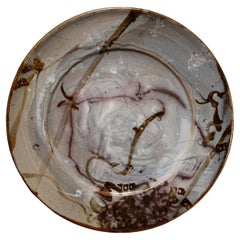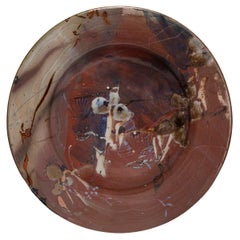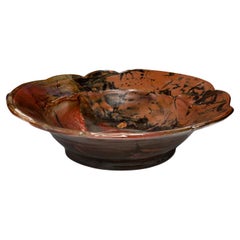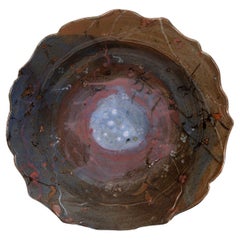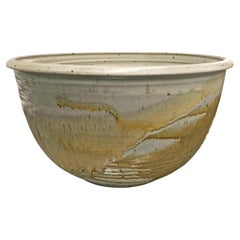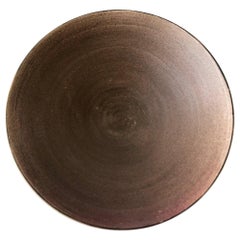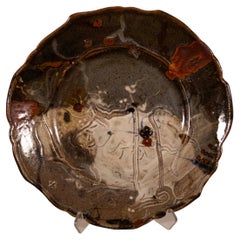John Glick Decorative Dishes and Vide-Poche
to
5
5
1
4
3
5
5
5
5
Height
to
Width
to
5
5
5
11
46
37
34
25
Creator: John Glick
John Glick Plum Street Pottery Ceramic Charger Monumental
By John Glick
Located in Bloomfield Hills, MI
The ceramic charger is an example of the kind of work by which John Glick became so famous. He was seduced by the effects of the reduction kiln, which decreased the levels of oxygen during firing, inducing the flame to pull oxygen out of the clay and glazes changing the colors of the glazes depending on their iron and copper content. In this way he achieved the rich gradients of ochre and umber and variations in stippling and opacity. It is signed by the artist and stamped with Plum Street Pottery #129 on the verso.
John was an American Abstract Expressionist ceramicist born in Detroit, MI. Though open to artistic experimentation, Glick was most influenced by the styles and aesthetics of Asian pottery—an inspiration that shows in his use of decorative patterns and glaze choices. He has said that he is attracted to simplicity, as well as complexity: my work continually reflects my re-examination that these two poles can coexist… or not, in a given series. Glick also took influences from master potters of Japan, notably Shoji Hamada and Kanjrio Kawai, blending their gestural embellishments of simple forms with attitudes of Abstract Expressionism. He was particularly drown to the work of Helen Frankenthaler whose soak-stain style resonated with Glick’s multi-layered glaze surfaces, which juxtaposed veils of atmospheric color with gestural marks and pattern. He spent countless hours developing and making his own tools in order to achieve previously unseen results in his work with clay and glaze.
Glick’s “Plum Tree Pottery” (now a designated historic landmark in Farmington Hills, Michigan) studio opened around 1965 and closed in the summer of 2016. It was a private studio space for John and a number of his students and assistants. He believed his shapes evolved guided by forces apparently outside his control. This was instinctual, intellectual and due to his openness to change, fusing into what he thought was the most positive force behind a potter’s approach: evolution and growth. Some have called it inspiration.
John was not only a major figure in the Detroit creative community, but in the ceramics world at large. According to Shelley Selim in her book on John, “John Glick: A Legacy in Clay” John remains: “one of the most recognizable names in the field of studio pottery – known for lecturing, publishing, and offering workshops widely – and his work has been featured in well over a hundred local, national and international exhibitions since he was a college student in the late 1950s.” Along with this John has mentored over thirty studio apprentices over five and a half decades, received numerous grants and awards for his work, and has been prolific, with an estimated 300,000 ceramic wares throughout the world.
He received his Masters from Cranbrook Academy of Art in Bloomfield Hills, Michigan, working with Maija Grotell, a legendary and influential teacher. Grotell was noted for her deep interest in the human connection to nature’s rhythms and patters. These ideas often grounded her dialog with her students including Glick, affecting, a profund and lasting influence on his future work. This famous Art Academy was designed by architect and faculty member, Eliel Saarinen who collaborated with Charles and Ray Eames on chair and furniture design. Numerous creative artists who are alumni of Cranbrook include: Harry Bertoia, Florence Knoll, Jack Lenor Larsen, Donald Lipski, Duane Hanson, Nick Cave, Hani Rashid, George Nelson, Urban Jupena (Nationally recognized fiber artist), Artis Lane (the first African-American artist to have her sculpture, "Sojourner Truth," commissioned for the Emancipation Hall in the Capital Visitor Center in Washington DC), Cory Puhlman (televised Pastry Chef extraordinaire), Thom O’Connor (Lithographs), Paul Evans (Brutalist-inspired sculpted metal furnishings), Eugene Caples (small bronze images/abstract), Morris Brose (Bronze Sculptures), Herb Babcock (blown glass), Larry Butcher (mixed media) and Lauren Anais Hussey...
Category
1990s American Expressionist John Glick Decorative Dishes and Vide-Poche
Materials
Ceramic
John Glick Plum Street Pottery Ceramic Charger Monumental
By John Glick
Located in Bloomfield Hills, MI
The ceramic charger is an example of the kind of work by which John Glick became so famous. He was seduced by the effects of the reduction kiln, which decreased the levels of oxygen during firing, inducing the flame to pull oxygen out of the clay and glazes changing the colors of the glazes depending on their iron and copper content. In this way he achieved the rich gradients of ochre and umber and variations in stippling and opacity. It is signed by the artist and stamped with Plum Street Pottery on the verso.
John was an American Abstract Expressionist ceramicist born in Detroit, MI. Though open to artistic experimentation, Glick was most influenced by the styles and aesthetics of Asian pottery—an inspiration that shows in his use of decorative patterns and glaze choices. He has said that he is attracted to simplicity, as well as complexity: my work continually reflects my re-examination that these two poles can coexist… or not, in a given series. Glick also took influences from master potters of Japan, notably Shoji Hamada and Kanjrio Kawai, blending their gestural embellishments of simple forms with attitudes of Abstract Expressionism. He was particularly drown to the work of Helen Frankenthaler whose soak-stain style resonated with Glick’s multi-layered glaze surfaces, which juxtaposed veils of atmospheric color with gestural marks and pattern. He spent countless hours developing and making his own tools in order to achieve previously unseen results in his work with clay and glaze.
Glick’s “Plum Tree Pottery” (now a designated historic landmark in Farmington Hills, Michigan) studio opened around 1965 and closed in the summer of 2016. It was a private studio space for John and a number of his students and assistants. He believed his shapes evolved guided by forces apparently outside his control. This was instinctual, intellectual and due to his openness to change, fusing into what he thought was the most positive force behind a potter’s approach: evolution and growth. Some have called it inspiration.
John was not only a major figure in the Detroit creative community, but in the ceramics world at large. According to Shelley Selim in her book on John, “John Glick: A Legacy in Clay” John remains: “one of the most recognizable names in the field of studio pottery – known for lecturing, publishing, and offering workshops widely – and his work has been featured in well over a hundred local, national and international exhibitions since he was a college student in the late 1950s.” Along with this John has mentored over thirty studio apprentices over five and a half decades, received numerous grants and awards for his work, and has been prolific, with an estimated 300,000 ceramic wares throughout the world.
He received his Masters from Cranbrook Academy of Art in Bloomfield Hills, Michigan, working with Maija Grotell, a legendary and influential teacher. Grotell was noted for her deep interest in the human connection to nature’s rhythms and patters. These ideas often grounded her dialog with her students including Glick, affecting, a profund and lasting influence on his future work. This famous Art Academy was designed by architect and faculty member, Eliel Saarinen who collaborated with Charles and Ray Eames on chair and furniture design. Numerous creative artists who are alumni of Cranbrook include: Harry Bertoia, Florence Knoll, Jack Lenor Larsen, Donald Lipski, Duane Hanson, Nick Cave, Hani Rashid, George Nelson, Urban Jupena (Nationally recognized fiber artist), Artis Lane (the first African-American artist to have her sculpture, "Sojourner Truth," commissioned for the Emancipation Hall in the Capital Visitor Center in Washington DC), Cory Puhlman (televised Pastry Chef extraordinaire), Thom O’Connor (Lithographs), Paul Evans (Brutalist-inspired sculpted metal furnishings), Eugene Caples (small bronze images/abstract), Morris Brose (Bronze Sculptures), Herb Babcock (blown glass), Larry Butcher (mixed media) and Lauren Anais Hussey...
Category
1990s American Expressionist John Glick Decorative Dishes and Vide-Poche
Materials
Ceramic
John Glick Plum Street Pottery Ceramic Glazed Bowl/Charger Extra-large
By John Glick
Located in Bloomfield Hills, MI
The ceramic bowl is an example of the kind of work by which John Glick became so famous. He was seduced by the effects of the reduction kiln, which decreased the levels of oxygen during firing, inducing the flame to pull oxygen out of the clay and glazes changing the colors of the glazes depending on their iron and copper content. In this way he achieved the rich gradients of ochre and umber and variations in stippling and opacity. It is signed by the artist and stamped with Plum Street Pottery on the verso.
John was an American Abstract Expressionist ceramicist born in Detroit, MI. Though open to artistic experimentation, Glick was most influenced by the styles and aesthetics of Asian pottery—an inspiration that shows in his use of decorative patterns and glaze choices. He has said that he is attracted to simplicity, as well as complexity: my work continually reflects my re-examination that these two poles can coexist… or not, in a given series. Glick also took influences from master potters of Japan, notably Shoji Hamada and Kanjrio Kawai, blending their gestural embellishments of simple forms with attitudes of Abstract Expressionism. He was particularly drown to the work of Helen Frankenthaler whose soak-stain style resonated with Glick’s multi-layered glaze surfaces, which juxtaposed veils of atmospheric color with gestural marks and pattern. He spent countless hours developing and making his own tools in order to achieve previously unseen results in his work with clay and glaze.
Glick’s “Plum Tree Pottery” (now a designated historic landmark in Farmington Hills, Michigan) studio opened around 1965 and closed in the summer of 2016. It was a private studio space for John and a number of his students and assistants. He believed his shapes evolved guided by forces apparently outside his control. This was instinctual, intellectual and due to his openness to change, fusing into what he thought was the most positive force behind a potter’s approach: evolution and growth. Some have called it inspiration.
John was not only a major figure in the Detroit creative community, but in the ceramics world at large. According to Shelley Selim in her book on John, “John Glick: A Legacy in Clay” John remains: “one of the most recognizable names in the field of studio pottery – known for lecturing, publishing, and offering workshops widely – and his work has been featured in well over a hundred local, national and international exhibitions since he was a college student in the late 1950s.” Along with this John has mentored over thirty studio apprentices over five and a half decades, received numerous grants and awards for his work, and has been prolific, with an estimated 300,000 ceramic wares throughout the world.
He received his Masters from Cranbrook Academy of Art in Bloomfield Hills, Michigan, working with Maija Grotell, a legendary and influential teacher. Grotell was noted for her deep interest in the human connection to nature’s rhythms and patters. These ideas often grounded her dialog with her students including Glick, affecting, a profund and lasting influence on his future work. This famous Art Academy was designed by architect and faculty member, Eliel Saarinen who collaborated with Charles and Ray Eames on chair and furniture design. Numerous creative artists who are alumni of Cranbrook include: Harry Bertoia, Florence Knoll, Jack Lenor Larsen, Donald Lipski, Duane Hanson, Nick Cave, Hani Rashid, George Nelson, Urban Jupena (Nationally recognized fiber artist), Artis Lane (the first African-American artist to have her sculpture, "Sojourner Truth," commissioned for the Emancipation Hall in the Capital Visitor Center in Washington DC), Cory Puhlman (televised Pastry Chef extraordinaire), Thom O’Connor (Lithographs), Paul Evans (Brutalist-inspired sculpted metal furnishings), Eugene Caples (small bronze images/abstract), Morris Brose (Bronze Sculptures), Herb Babcock (blown glass), Larry Butcher (mixed media) and Lauren Anais Hussey...
Category
Late 20th Century American John Glick Decorative Dishes and Vide-Poche
Materials
Ceramic
John Glick Modernist Stoneware Glazed Ceramic Pottery Tea Pot Plum Tree Pottery
By John Glick
Located in Keego Harbor, MI
A modernist stoneware glazed ceramic tea pot by Detroit artist John Glick of Plum Tree Pottery. Circa late 20th century. Glazed in earthtones. Artisisnal yet functional and makes a u...
Category
Mid-20th Century American John Glick Decorative Dishes and Vide-Poche
Materials
Ceramic
John Glick Plum Street Pottery Signed Monumental Ceramic Charger
By John Glick
Located in Bloomfield Hills, MI
The ceramic charger with scalloped edge is an example of the kind of work by which John Glick became so famous. He was seduced by the effects of the reduction kiln, which decreased the levels of oxygen during firing, inducing the flame to pull oxygen out of the clay and glazes changing the colors of the glazes depending on their iron and copper content. In this way he achieved the rich gradients of ochre and umber and variations in stippling and opacity. It is signed on verso.
John was an American Abstract Expressionist ceramicist born in Detroit, MI. Though open to artistic experimentation, Glick was most influenced by the styles and aesthetics of Asian pottery—an inspiration that shows in his use of decorative patterns and glaze choices. He has said that he is attracted to simplicity, as well as complexity: my work continually reflects my re-examination that these two poles can coexist… or not, in a given series. Glick also took influences from master potters of Japan, notably Shoji Hamada and Kanjrio Kawai, blending their gestural embellishments of simple forms with attitudes of Abstract Expressionism. He was particularly drown to the work of Helen Frankenthaler whose soak-stain style resonated with Glick’s multi-layered glaze surfaces, which juxtaposed veils of atmospheric color with gestural marks and pattern. He spent countless hours developing and making his own tools in order to achieve previously unseen results in his work with clay and glaze.
Glick’s “Plum Tree Pottery” (now a designated historic landmark in Farmington Hills, Michigan) studio opened around 1965 and closed in the summer of 2016. It was a private studio space for John and a number of his students and assistants. He believed his shapes evolved guided by forces apparently outside his control. This was instinctual, intellectual and due to his openness to change, fusing into what he thought was the most positive force behind a potter’s approach: evolution and growth. Some have called it inspiration.
John was not only a major figure in the Detroit creative community, but in the ceramics world at large. According to Shelley Selim in her book on John, “John Glick: A Legacy in Clay” John remains: “one of the most recognizable names in the field of studio pottery – known for lecturing, publishing, and offering workshops widely – and his work has been featured in well over a hundred local, national and international exhibitions since he was a college student in the late 1950s.” Along with this John has mentored over thirty studio apprentices over five and a half decades, received numerous grants and awards for his work, and has been prolific, with an estimated 300,000 ceramic wares throughout the world.
He received his Masters from Cranbrook Academy of Art in Bloomfield Hills, Michigan, working with Maija Grotell, a legendary and influential teacher. Grotell was noted for her deep interest in the human connection to nature’s rhythms and patters. These ideas often grounded her dialog with her students including Glick, affecting, a profund and lasting influence on his future work. This famous Art Academy was designed by architect and faculty member, Eliel Saarinen who collaborated with Charles and Ray Eames on chair and furniture design. Numerous creative artists who are alumni of Cranbrook include: Harry Bertoia, Florence Knoll, Jack Lenor Larsen, Donald Lipski, Duane Hanson, Nick Cave, Hani Rashid, George Nelson, Urban Jupena (Nationally recognized fiber artist), Artis Lane (the first African-American artist to have her sculpture, "Sojourner Truth," commissioned for the Emancipation Hall in the Capital Visitor Center in Washington DC), Cory Puhlman (televised Pastry Chef extraordinaire), Thom O’Connor (Lithographs), Paul Evans (Brutalist-inspired sculpted metal furnishings), Eugene Caples (small bronze images/abstract), Morris Brose (Bronze Sculptures), Herb Babcock (blown glass), Larry Butcher (mixed media) and Lauren Anais Hussey...
Category
1990s American Expressionist John Glick Decorative Dishes and Vide-Poche
Materials
Ceramic
Related Items
Monumental Mid-20th Century American Studio Pottery Bowl
Located in Chicago, IL
A monumental-scale mid-20th century American studio hand-thrown glazed ceramic bowl with fantastic texture and earthy neutral glaze colors. Signed illegibly on the bottom.
Category
1970s American Mid-Century Modern Vintage John Glick Decorative Dishes and Vide-Poche
Materials
Ceramic
Early Laura Andreson California Modernist Ceramic Stoneware Bowl
By Laura Andreson
Located in Palm Springs, CA
Large Laura Anderson stoneware bowl measuring 3.5" in height by 11.25" diameter. Signed Laura Anderson, 1949. In very good vintage condition.
The fol...
Category
1940s American Mid-Century Modern Vintage John Glick Decorative Dishes and Vide-Poche
Materials
Stoneware
$1,320 Sale Price
20% Off
H 3.5 in Dm 11.25 in
Signed Vintage Pottery
Located in Seattle, WA
Signed vintage pottery. Grey blue abstract design on a bowl with the signature on the bottom.
Dimensions Diameter 12 ; 4 1/4 H.
Category
1970s Mid-Century Modern Vintage John Glick Decorative Dishes and Vide-Poche
Materials
Ceramic
Japanese Asian Signed Studio Pottery Wabi-Sabi Ceramic Glazed Chawan Tea Bowl
Located in Studio City, CA
A stunning Japanese stoneware studio pottery chawan tea bowl that features a beautiful, heavy and sumptuously multi-glaze with wonderful shifts in color and texture. This bowl is wit...
Category
20th Century Japanese Showa John Glick Decorative Dishes and Vide-Poche
Materials
Stoneware
$695
H 3.25 in W 5.25 in D 5.25 in
Extra Large Bowl in Selenite
By Kathryn McCoy
Located in West Hollywood, CA
Indulge in the captivating allure of Kathryn McCoy's Rock Crystal Collection, a masterpiece that seamlessly blends nature's raw beauty with exquisite craftsmanship. Available in vari...
Category
21st Century and Contemporary American Modern John Glick Decorative Dishes and Vide-Poche
Materials
Rock Crystal
Toshiko Takaezu Signed Japanese Hawaiian Glazed Pottery Chawan Yunomi Tea Bowl
By Toshiko Takaezu
Located in Studio City, CA
An absolutely gorgeous and wonderful chawan tea bowl / yunomi cup by famed Japanese American pottery master Toshiko Takaezu. The work features a rich, matte black tenmoku glaze with ...
Category
Mid-20th Century American Mid-Century Modern John Glick Decorative Dishes and Vide-Poche
Materials
Pottery
$995
H 2.1 in Dm 3.25 in
Monumental Sponge Ware Pottery Bowl
By Roseville Pottery
Located in Los Angeles, CA
This huge signed Roseville sponge ware pottery mixing bowl is in pristine condition. These large size bowls are super rare and in fine condition is even be...
Category
Early 20th Century American Adirondack John Glick Decorative Dishes and Vide-Poche
Materials
Pottery
Arne Bang Signed Monumental Midcentury Danish Scandinavian Ceramic Pottery Bowl
By Arne Bang
Located in Studio City, CA
A wonderful and rare large work by Danish designer Arne Bang. Truly special.
Beautifully glazed and signed with artist mark and number on the base.
Would be a great addition to...
Category
Early 20th Century Danish Mid-Century Modern John Glick Decorative Dishes and Vide-Poche
Materials
Ceramic
$3,250
H 4 in W 9.25 in D 9.25 in
Mid-Century Modern Studio Ceramic Stoneware Pot by Mark Zamantakis
By Mark Zamantakis
Located in Topeka, KS
Handsome Mid-Century Modern stoneware pot by artist Mark Zamantakis from his Colorado ceramic studio. It is in wonderful vintage condition. No cracks o...
Category
Mid-20th Century American Mid-Century Modern John Glick Decorative Dishes and Vide-Poche
Materials
Stoneware
Vintage Mid Century Modern Ceramic Studio Signed Stamped Pottery Bowl.
Located in Miami, FL
Vintage Mid Century Modern Ceramic Studio Signed Stamped Pottery Bowl. Circa 1960s
Features a brutalist inspired design with an incised raw partially glazed exterior and an abstrac...
Category
1960s Unknown Mid-Century Modern Vintage John Glick Decorative Dishes and Vide-Poche
Materials
Ceramic
Anne Goldman organic ceramic / pottery large bowl , centerpiece , signed .
By Anne Goldman
Located in Los Angeles, CA
Amazing organic bowl very textured by the well known artist Anne Goldman . Her pieces are in Museums , Collections and Organizations all over the world .
Category
Late 20th Century American Modern John Glick Decorative Dishes and Vide-Poche
Materials
Pottery
Ceramic Stoneware Tea Bowl in Shino Style by Warren Mackenzie
By Warren MacKenzie
Located in Atlanta, GA
A stoneware tea bowl by American ceramist Warren Mackenzie (1924-2018). Potted in a column shape with a prominent encircling ridged node in the midsection, the upright bowl evokes th...
Category
20th Century American Modern John Glick Decorative Dishes and Vide-Poche
Materials
Ceramic
Previously Available Items
John Glick Plum Tree Charger Plate Pottery Mid Century Modern
By John Glick
Located in Keego Harbor, MI
Discover this captivating Mid Century Modern Plum Tree Charger Plate by the renowned potter John Glick. This artistic ceramic plate is a conve...
Category
Mid-20th Century Unknown Mid-Century Modern John Glick Decorative Dishes and Vide-Poche
Materials
Ceramic
John Glick decorative dishes and vide-poche for sale on 1stDibs.
John Glick decorative dishes and vide-poche are available for sale on 1stDibs. These distinctive items are frequently made of ceramic and are designed with extraordinary care. Prices for John Glick decorative dishes and vide-poche can differ depending upon size, time period and other attributes — on 1stDibs, these items begin at $1,250 and can go as high as $3,500, while a piece like these, on average, fetch $2,940.
